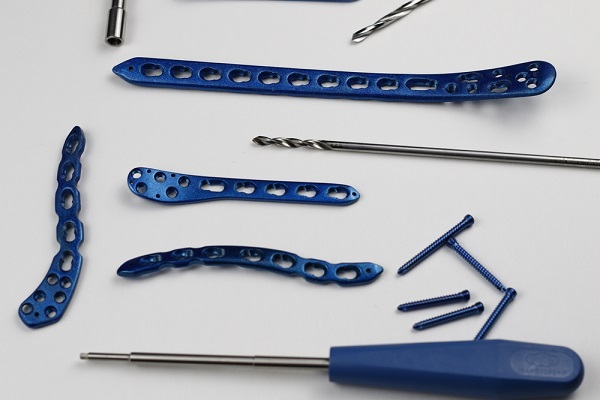
Locking Plates vs. Non-Locking Plates: Which Provides Better Fracture Stability?
Orthopedic trauma care has evolved significantly over the past few decades, thanks to the development of advanced surgical techniques and implant technologies. One of the most critical decisions orthopedic surgeons must make when treating fractures is choosing the right type of fixation device. Among the most commonly used internal fixation methods are locking plates and non-locking plates. These devices serve the same fundamental purpose—stabilizing broken bones to promote proper healing—but their mechanics, applications, and clinical outcomes can differ considerably. This brings us to a key question: Which provides better fracture stability—locking plates or non-locking plates?
Understanding the Basics: Locking Plates and Non-Locking Plates
Before diving into a comparison, it's essential to understand what these two types of plates are and how they function.
Non-locking plates, also known as conventional plates, have been a mainstay in orthopedic surgery for decades. They rely on the compression between the bone and the plate for stability. The screws used in non-locking plates compress the plate onto the bone, essentially sandwiching the fractured segments into place. This technique allows for dynamic stability but depends heavily on bone quality and accurate anatomical reduction.
Locking plates, on the other hand, represent a more modern approach. They use threaded screw holes that "lock" the screw head into the plate, creating a fixed-angle construct. This mechanism does not rely on bone-plate compression but rather on angular stability. As a result, locking plates can maintain stable fixation even in poor-quality or osteoporotic bone where traditional plating might fail.
Mechanical Stability: Fixed Angle vs. Frictional Hold
One of the most significant differences between locking and non-locking plates lies in the type of stability they offer.
Non-locking plates depend on frictional stability. The screw compresses the plate against the bone, and the resistance to motion comes from the tight interface between the plate and the bone. If the bone quality is compromised, such as in cases of osteoporosis or comminuted fractures, this frictional hold may be insufficient, leading to loosening or failure.
In contrast, locking plates provide fixed-angle stability, which is more robust and predictable. Since the screw locks into the plate itself, the forces are distributed more evenly through the construct, and the plate doesn’t need to be tightly compressed against the bone. This minimizes the risk of compromising blood supply to the bone and allows for improved healing, especially in complex or unstable fractures.
Biological Considerations
Fracture healing is not solely a mechanical process—it’s also deeply biological. Here, locking plates offer certain advantages due to their “internal external fixator” concept. Because they don’t require tight contact with the bone, locking plates preserve the periosteal blood supply, which is crucial for bone regeneration. This is particularly important in cases where the soft tissue around the fracture is already compromised, such as open fractures or high-energy trauma.
Non-locking plates, by contrast, require extensive bone contact, which can disturb the periosteum and reduce vascularity, potentially delaying or impairing healing.
Indications and Clinical Scenarios
The choice between locking and non-locking plates often depends on the specific fracture pattern and patient characteristics.
Non-locking plates may be preferred in:
- Simple fractures with good bone quality
- Situations where anatomical reduction is critical
- Cases where cost is a significant consideration
- Diaphyseal (mid-shaft) fractures with straightforward alignment
Locking plates, however, are better suited for:
- Osteoporotic or elderly patients with fragile bones
- Comminuted or multi-fragmentary fractures
- Periarticular fractures where stable angular fixation is required
- Minimally invasive surgical techniques (MIPO)
- Poor soft tissue conditions where less plate-bone contact is ideal
Research and Evidence
Numerous biomechanical and clinical studies have compared locking plates and non-locking plates, often with compelling results in favor of locking plates when it comes to challenging fracture types.
A study published in the Journal of Orthopaedic Trauma found that locking plates provide superior stability in osteoporotic bone compared to traditional plating systems. Another biomechanical study demonstrated that locking plates significantly reduce the risk of screw pull-out and construct failure, particularly in metaphyseal regions where bone density is low.
However, not all research paints locking plates as universally superior. In straightforward, transverse fractures in healthy bone, non-locking plates can perform equally well, provided the surgical technique is precise. In fact, due to their lower cost and ease of contouring, non-locking plates remain a valuable tool in many settings, especially in resource-limited environments.
Cost vs. Benefit Considerations
Locking plates, while technologically advanced, come at a higher price point. This can be a limiting factor in many healthcare systems, especially in developing countries. Hospitals and surgeons must carefully weigh the benefits of improved stability against the increased cost of implants and instrumentation.
Non-locking plates, being more economical, still hold a strong position in many trauma centers worldwide, particularly when treating fractures in patients with good bone stock and straightforward patterns.
Surgeon Skill and Learning Curve
It’s worth noting that locking plate fixation requires a different mindset and skill set than traditional plating. Proper use of locking constructs involves understanding indirect reduction techniques, biological fixation principles, and bridge plating concepts. Misuse of locking plates—such as over-reliance on rigidity or incorrect placement—can lead to complications like non-union or implant failure.
Non-locking plates, while more familiar to many surgeons, demand high precision in bone apposition and screw placement to avoid loss of fixation. Both systems require a high degree of surgical expertise, but locking plates, in particular, have a steeper learning curve.
Final Verdict: Which Is Better?
The answer to the question, which provides better fracture stability: locking or non-locking plates?—is context-dependent.
If the goal is to treat a complex, unstable, or osteoporotic fracture where angular stability is critical, locking plates offer superior mechanical and biological advantages. They are particularly beneficial in elderly populations, periarticular injuries, and high-energy trauma cases where standard plating might fail.
However, non-locking plates are still highly effective, less expensive, and easier to use for simple fractures in younger patients with healthy bone. When used correctly, they can provide excellent outcomes with minimal complications.
In summary, locking plates are not inherently better in every situation, but they offer a powerful tool in the hands of a skilled surgeon dealing with the right clinical indications. The best outcomes are achieved when the implant is tailored to the patient, the fracture, and the surgical environment.
Leave a Comment
© Copyright © 2024 gwsmed.com | GWS Surgicals LLP. All rights reserved.
| |




Comment (0)
No Comments Yet. Be the first one.